
Daufuskie Island, located between Hilton Head Island and Savannah, is the southernmost inhabited sea island in South Carolina. It is 5 miles (8 km) long by almost 2.5 miles (4.0 km) wide – approximate surface area of 8 square miles (21 km2). With over 3 miles (5 km) of beachfront, Daufuskie is surrounded by the waters of Calibogue Sound, the Intracoastal Waterway and the Atlantic Ocean. It was listed as a census-designated place in the 2020 census with a population of 557.

The Hunting Island Light is located in Hunting Island State Park on Hunting Island near Beaufort, South Carolina. Although no longer used as a functioning lighthouse, the tower is a fixture at the state park and is open to visitors. It was named to the National Register of Historic Places in 1970.

The Gasparilla Island Lights are on Gasparilla Island in Boca Grande, Florida. The Port Boca Grande Lighthouse is on the southern tip of Gasparilla Island, and marked the Boca Grande Pass entrance to Charlotte Harbor.

Liston Range Rear Lighthouse is a lighthouse in Delaware, United States, on the Delaware River. The 120 feet (37 m) wrought iron tower was made by the Kellogg Bridge Company of Buffalo, New York. The light was built several miles to the east of its present location in 1876–1877, and was moved in 1906. The light was listed on the National Register of Historic Places in 1978. It is the tallest lighthouse in Delaware.

The St. Simons Island Light is a lighthouse on the southern tip of St. Simons Island, Georgia, United States. It guides ships into St. Simons Sound and warns of the many sandbars in the area.

St. Clair Flats Front and Rear Range Light are two lighthouse structures situated off the southeastern tip of Harsens Island at Lake St. Clair.

The Copper Harbor Light is a lighthouse located in the harbor of Copper Harbor, Michigan USA on the Keweenaw Peninsula of Upper Michigan inside Fort Wilkins Historic State Park. It is a Michigan State Historic Site and listed on the National Register of Historic Places.
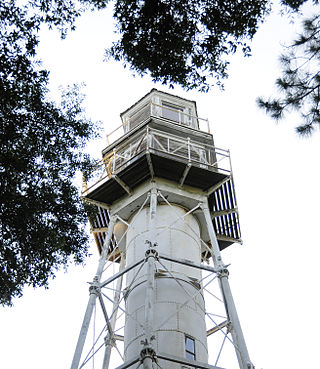
The Rear Lighthouse of Hilton Head Range Light Station, which is also called Leamington Lighthouse is an inactive light station on Hilton Head Island in Beaufort County, South Carolina. In 1983, it was named to the National Register of Historic Places.

The Haig Point Range Lights were range lights on Calibogue Sound at the northeastern end of Daufuskie Island in Beaufort County, South Carolina. The Haig Point Range Lights were built in 1873 and were maintained as an official aid to navigation until about 1924. The Rear Range Light house has been restored. It is a guest house for the Haig Point Club and serves as a private aid to navigation.

The Cove Island Light, at Gig Point on the island, is located in Fathom Five National Marine Park, but is not part of the Park. It is situated on the Bruce Peninsula, Ontario Canada. It has been a navigational aid in the narrow channel between Lake Huron and Georgian Bay since 30 October 1858. It was the first of six stone Imperial Towers to be completed; all were illuminated by 1859. Most other lighthouses of the era were built of brick, wood, iron or concrete.
The Parris Island Range Lights were range lights on the southern end of Parris Island in Beaufort County, South Carolina. The Parris Range Lights were first lit in 1881. They were deactivated in 1912. Only the lens house for the Rear Light remains, which is the oldest building at Parris Island.

The Sullivan's Island Range Lights were range lights on the southern end of Sullivan's Island in Charleston County, South Carolina. The light station was first established in 1848 and was destroyed in 1861 during the Civil War. It was rebuilt after the war and the lights were in existence at least as late as 1901. Neither of the range lights still remains today.

The Harbour Town Lighthouse is a lighthouse at the Harbour Town Marina at Hilton Head Island, South Carolina. It was privately built and is a private aid to navigation. Although initially ridiculed by local residents during the planning and construction phases, the lighthouse became instantly popular and is today the most recognizable symbol of Hilton Head Island and Sea Pines Resort. The annually televised The Heritage golf tournament has helped increase the lighthouse's fame to millions of golf fans worldwide, and the 18th hole at the Harbour Town Golf Links has become one of the most popular and recognizable finishing holes in golf.
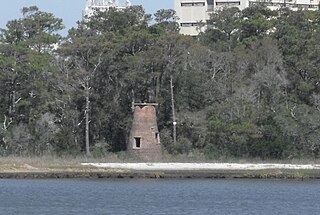
The Price Creek Lighthouse, also known as the Price's Creek Lighthouse, is a structure located near Southport, North Carolina. It was one of two range lights at Price Creek in a series of lights to guide ships from Cape Fear to Wilmington, North Carolina.
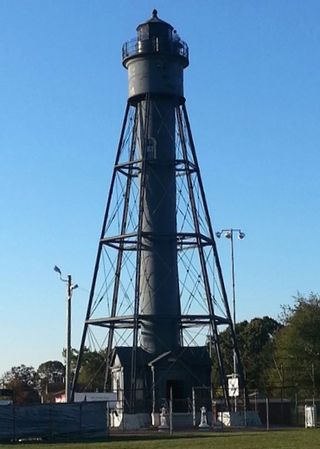
The Tinicum Island Rear Range Light is a lighthouse located in the Billingsport section of Paulsboro in Gloucester County, New Jersey, the rear of a pair of range lights marking a section of the channel in the Delaware River south of Philadelphia.
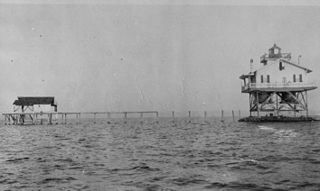
The Cat Island Light was a lighthouse located on Cat Island off the coast of Mississippi. Originally built to guide shipping through the Mississippi Sound, it was discontinued as traffic moved further south.

The Wood Islands Lighthouse is a historic lighthouse built by Donald MacMillan situated on the southeastern shore of Prince Edward Island, located in the community of Wood Islands. The lighthouse is a well-preserved three storey tower with an adjoining 1+1⁄2-storey keeper's residence. The white shingled tower is topped by a red iron lantern, which is enclosed by a white railing on the observation deck. The red roof of the dwelling provides a striking contrast to the white shingled exterior of the dwelling.
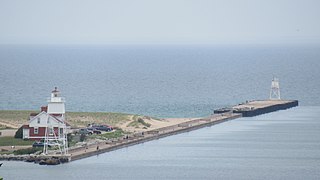
The Grand Marais Harbor of Refuge Inner and Outer Lights are a pair of lighthouses located on the west pier at the entry to Grand Marais Harbor of Refuge, in Grand Marais, Michigan. They were listed on the National Register of Historic Places in 2012.
Bloody Point is a residential community on the southernmost tip of Daufuskie Island, South Carolina, United States. It is bordered by the Atlantic Ocean on one side and Mungen River on the other.

Cape Race Lighthouse is an active lighthouse located at Cape Race on the Avalon Peninsula, Newfoundland. The light's characteristic is a single white flash every 7.5 seconds; additionally, a foghorn may sound a signal of two blasts every 60 seconds. It is located on one of Canada's busiest shipping lanes. The lighthouse is also a tourist attraction.


















